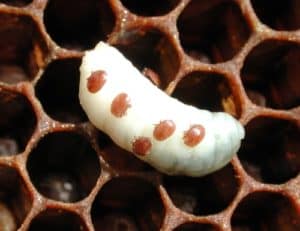It was a couple weeks ago that Heather, Jennie and I were talking about using drone comb as Varroa management in a colony. Drone larvae are particularly attractive to Varroa mites. By adding drone comb to a hive, a beekeeper is creating a lure for the mites in the hope that they will go to the drone larvae instead of infecting precious worker larvae. Once the drone brood is capped, the beekeeper removes the frame and freezes it, thoroughly killing the pesky mites.

While it is apparent that Varroa are attracted to drone larvae, it occurred to me, why is this so? What makes drone larvae so appetizing to the mites that they will overlook other healthy larvae and attack it first?
These questions have been running through my head for weeks and although I have my own guesses, I decided it was a good time to ask around. Karen Rennich our project manager provided some insight. She pointed out to me that drone larvae take much longer to mature than worker larvae. The mites have much more time to reproduce while also allowing more time to mature before the drone emerges. There is also research that the Varroa can distinguish the difference between worker brood and drone brood by smell.
Could it be that Varroa mites have somehow evolved to ‘know’ that drone larvae provides a home with a longer lease? Although the mite does not consciously seek out drone brood, several bee researchers have found that Varroa mites identify drone larvae by pheromone markings. There are a multitude of reasons why drone larvae is specifically appetizing for Varroa and I believe that over time the pest has evolved to instinctively identify the pheromones of drone larvae and infect them instead of worker larvae.

What is really important about this particular relationship is that using drone comb really works to reduce mite population in the hive! Beekeepers who dislike using dangerous miticides can use this method with virtually no harm to the bees and with only a little added work in the hive.